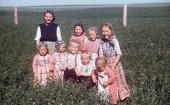
Both the Mennonites and the Hutterites trace their origins to the Swiss Anabaptist movements of the 16th century; and both groups immigrated, directly or indirectly, to the Canadian prairies from German colonies in South Russia, as had most of the German Catholics. But in the intervening period of over two centuries, their histories were quite distinct. While the Mennonite group was forming in the Netherlands, another communal Anabaptist group was developing in the South Tyrol (then in Austria, now in Italy), as well as later in southern Germany and Moravia (now within the Czech Republic). In 1528 the first real bruderhof (communal village or colony) was established in Moravia; five years later they were joined by a South Tyrolean preacher, Jacob Hutter, from whom the sect acquired its name. Despite repeated persecution (Hutter was burned at the stake in 1536), by the end of the century there were as many as 70,000 Hutterites and over ninety bruderhofe . Reduced in numbers by the Austro-Turkish and Thirty Years Wars, by 1622 they had all been driven from Moravia; some 20,000 had emigrated to Slovakia, Hungary, and Transylvania (now in Romania), where they had established over thirty new colonies. However, persecution continued, particularly by Jesuits seeking to convert them in Slovakia, and they were further decimated. A small number were briefly re-established at Kreutz, Transylvania, in 1763–70; caught in the midst of the Russo-Turkish Wars, 123 of them trekked to Russia (present-day Ukraine) to found the Vishenka and Radichev colonies.
Finally, their rather unsettled existence in Europe was terminated altogether in 1874 when all of them, numbering nearly 800, moved to South Dakota along with Mennonites and other Russian-German Protestant groups escaping the repeal of their military exemption by the Russian government. The Schmiedeleut, Dariusleut, and Lehrerleut sects separately founded three initial colonies between 1874 and 1877. But about half of the Hutterites decided to homestead individually rather than communally, thus becoming Prairieleut and eventually merging with the Mennonites who settled in the same area. World War I hastened the exodus of Dariusleut and Lehrerleut from the United States to Alberta, and of Schmiedeleut to Manitoba.
Each Hutterite colony averages approximately 100 men, women and children. Hutterites have tended to have a high, but recently declining, birth rate and a large family size; when a colony’s population grows well beyond the average, new “daughter” colonies are founded, usually about every fifteen years. Thus the Hutterite population as a whole and the number of colonies have grown quite rapidly. Prior to 1949 there were no Hutterite colonies in Saskatchewan; since then more than fifty colonies have been established, about equally divided between Dariusleut and Lehrerleut.
Hutterite colonies have tended to be concentrated in western regions of Saskatchewan, although they are becoming increasingly widespread. In the southwestern region, there are five colonies in the immediate vicinity of Maple Creek: Cypress (1952), Spring Creek (1956–58), New Wolf Creek or Downey Lake (1958), Box Elder (1960), and more recently Dinsmore (1976). Further east, another seventeen colonies are found in the Cypress Hills and around Swift Current: Bench (1949–52) west of Shaunavon was the very first colony in Saskatchewan and the initial Lehrerleut colony. During the 1950s and 1960s it was soon followed by Tompkins (1952–54), West Bench (1960), Simmie (1961), Waldeck (1962–63), Main Centre (1963), Sand Lake (1964), and Hodgeville (1969–71); then during the 1970s by Ponteix (1970–71), Swift Current (1976) and Vanguard (1979–80); during the 1980s by Carmichael (1983), Bone Creek (1988), Webb (1988), and Butte (1989); and most recently New Spring Creek (1993). Six colonies have been established in the Regina and Moose Jaw area: first Arm River (1964–68); then Baildon (1967–68), Huron (1968–69), Lajord (1977), Belle Plaine (1981), and Rose Valley (1985).
In the Sand Hills area north of Maple Creek, four colonies have been founded: Estuary (1958), Haven (1966–67), Abbey (1970–71), and Wheatland (1987). Sixteen colonies are widely scattered through the west country further north: Hillsvale (1960–61), Glidden (1962–63), Smiley (1966–68), Fort Pitt (1968–69), Sanctuary (1969– 70), Lakeview (1970), Rosetown (1970), Willow Park (1977), Beechy (1978), Golden View (1978), Spring Water (1979), Big Rose (1980), Eagle Creek (1981), Eatonia (1985), Sunny Dale (1988), and Springfield (1989). Several other colonies have been developed to the north and south of Saskatoon: Leask (1953–57) and Riverview (1956) were the earliest Dariusleut colonies in the province, followed by Hillcrest (1969) and Clear Springs (1969–71). Finally, to the northeast two colonies have been established: Quill Lake (1975) and Star City (1978).
All Hutterites continue to live in their own colonies, which are small in population yet often control extensive farmland. Although they sell their produce (grain, livestock, poultry, vegetable crops) on the public market, they live within sequestered colonies where strict conformity is ensured in unique dress, religious education (together with limited “public education” from an outside teacher at the colony school), language (they converse in an archaic German dialect), authority (each colony is ultimately headed by a male boss), occupational specificity (male and female jobs are assigned even before adulthood), holding property in common, and an orderly lifestyle (for example, preparing meals and dining together; buildings arranged in rectangular order). Because Hutterites own their farmland and machinery in common, their farming is usually a profitable venture. However, the rapid expansion of Hutterites’ territorial acquisitions has resulted in contested legislation in the prairie provinces, restricting concentration and expansion of the colonies. Moreover, Hutterites have traditionally tended to be non-political, to buy farm machinery on a wholesale rather than localized basis, and to claim tax exemptions as a religious organization, which has further caused problems in their relations with neighbouring local communities. Today, however, Hutterites are respected as prosperous farmers and as an interesting part of Saskatchewan’s rural population.
Alan Anderson